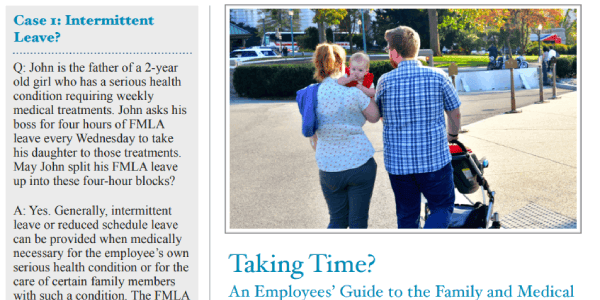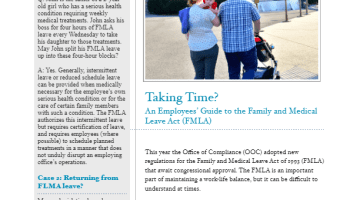Taking Time?
An Employees’ Guide to the Family and Medical Leave Act (FMLA)
This year the Office of Compliance (OOC) adopted new regulations for the Family and Medical Leave Act of 1993 (FMLA) that await congressional approval. The FMLA is an important part of maintaining a work-life balance, but it can be difficult to understand at times.
So, what is the FMLA?
In short, the FMLA allows employees to take up to 12 weeks of unpaid, job-protected leave for family and medical reasons (see below). While the FMLA does not require that leave be paid, it allows employing offices to substitute available paid leave for unpaid FMLA leave and allows employees to take FMLA designated leave without fear of being terminated or retaliated against. Although employees who take FMLA leave may not always return to the same job, they must be returned to positions with equivalent benefits, pay, and other terms of employment.
Who is eligible for FMLA leave?
Under the Congressional Accountability Act (CAA), which governs most workplace rights for the legislative branch, employees who have worked for any employing office in the legislative branch for at least 12 months (need not be consecutive or for a single office) and worked 1,250 hours during the preceding 12 months are eligible for FMLA leave.
What can FMLA leave be used for?
- The birth, adoption, or foster care placement of a child and to care for that child within one year of birth, adoption, or foster care placement;
- To care for a spouse, child, or parent who has a serious health condition, including 26 weeks to care for a spouse, child, parent, or next-of-kin who is a service member or veteran with a serious service connected injury or illness;
- A serious health condition that makes the employee unable to work;
- Any qualifying situation that arises when a spouse, child, or parent is on covered active duty military service or has been notified of an impending order to active duty, such as making child care arrangements for deploying military.

